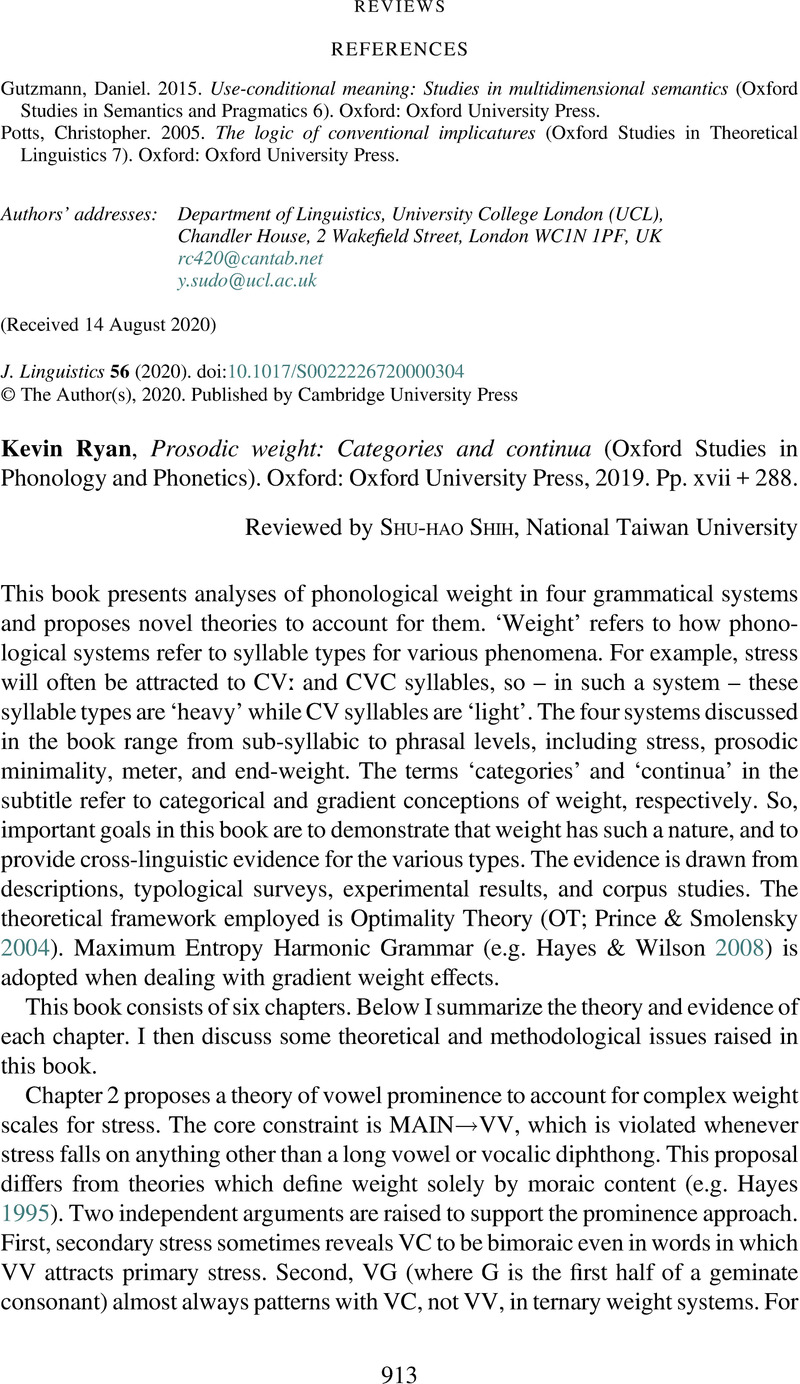No CrossRef data available.
Article contents
Kevin Ryan, Prosodic weight: Categories and continua (Oxford Studies in Phonology and Phonetics). Oxford: Oxford University Press, 2019. Pp. xvii + 288.
Review products
Kevin Ryan, Prosodic weight: Categories and continua (Oxford Studies in Phonology and Phonetics). Oxford: Oxford University Press, 2019. Pp. xvii + 288.
Published online by Cambridge University Press: 09 December 2020
Abstract
An abstract is not available for this content so a preview has been provided. Please use the Get access link above for information on how to access this content.

- Type
- Reviews
- Information
- Copyright
- © The Author(s), 2020. Published by Cambridge University Press
References
REFERENCES
Chen, Matthew Y. 2000. Tone sandhi: Patterns across Chinese dialects. Oxford: Oxford University Press.Google Scholar
de Lacy, , Paul, . 1997. Prosodic categorization. M.A. thesis, University of Auckland, New Zealand.Google Scholar
de Lacy, , Paul, . 2002. The formal expression of markedness. Ph.D. dissertation, University of Massachusetts Amherst.Google Scholar
de Lacy, , Paul, . 2004. Markedness conflation in Optimality Theory. Phonology 21, 145–199.Google Scholar
Goedemans, Rob & van Zanten, Ellen. 2007. Stress and accent in Indonesian. In van Heuven, Vincent & van Zanten, Ellen (eds.), Prosody in Indonesian languages, 35–62. Utrecht: LOT.Google Scholar
Gordon, Matthew. 2004. A phonological and phonetic study of word-level stress in Chickasaw. International Journal of American Linguistics 70, 1–32.Google Scholar
Hayes, Bruce. 1995. Metrical stress theory: Principles and case studies. Chicago, IL: University of Chicago Press.Google Scholar
Hayes, Bruce & Wilson, Colin. 2008. A maximum entropy model of phonotactics and phonotactic learning. Linguistic Inquiry 39, 379–440.CrossRefGoogle Scholar
Mishra, Mithilesh. 2006. The syllable structure and stress patterns of the Maithili language. Ph.D. dissertation, University of Illinois at Urbana–Champaign.Google Scholar
Morén, Bruce. 1999. Distinctiveness, coercion, and sonority. Ph.D. dissertation, University of Maryland, College Park.Google Scholar
Morén, Bruce. 2000. The puzzle of Kashmiri stress: Implications for weight theory. Phonology 17, 365–396.Google Scholar
Prince, Alan & Smolensky, Paul. 2004. Optimality Theory: Constraint interaction in generative grammar. Malden, MA & Oxford: Blackwell.Google Scholar
Rosenthall, Sam & van der Hulst, Harry. 1999. Weight-by-position by position. Natural Language & Linguistic Theory 17, 499–540.CrossRefGoogle Scholar
Shih, Shu-hao. 2016. Sonority-driven stress does not exist. In Gunnar Ólafur Hansson, Ashley Farris-Trimble, Kevin McMullin & Douglas Pulleyblank (eds.), Supplemental Proceedings of the 2015 Annual Meeting on Phonology. Washington, DC: Linguistic Society of America. doi:http://dx.doi.org/10.3765/amp.v3i0.3666.Google Scholar
Shih, Shu-hao. 2018a. On the existence of sonority-driven stress in Gujarati. Phonology 35, 327–364.Google Scholar
Shih, Shu-hao. 2018b. Non-moraic schwa: Phonology and phonetics. Ph.D. dissertation, Rutgers University.Google Scholar
Shih, Shu-hao & de Lacy, Paul. 2019. Evidence for sonority-driven stress. Catalan Journal of Linguistics 18, 9–40.Google Scholar
Tabain, Marija, Fletcher, Janet & Butcher, Andrew. 2014. Lexical stress in Pitjantjatjara. Journal of Phonetics 42, 52–66.Google Scholar




